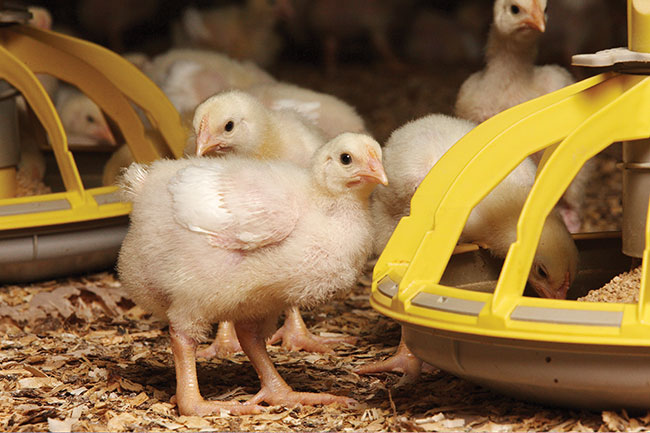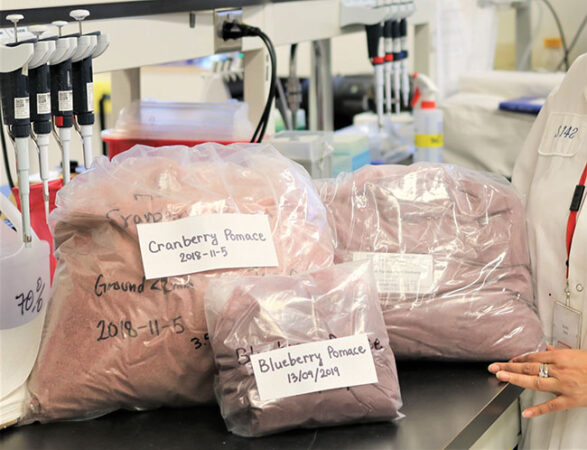
Nutrition Research: The promise of pomace
By Jane Robinson
Features Nutrition and FeedGroundbreaking research on berry pomace as poultry feed offers a sustainable, non-antibiotic solution.
 Broilers fed a diet supplemented with berry pomace showed an improved gut microbiome and an increased immune response for a stronger defence against pathogenic bacteria.
PHOTO CREDIT: Dr. Moussa Sory Diarra
Broilers fed a diet supplemented with berry pomace showed an improved gut microbiome and an increased immune response for a stronger defence against pathogenic bacteria.
PHOTO CREDIT: Dr. Moussa Sory Diarra Nearly 20 years ago, Dr. Moussa Sory Diarra began looking at using food waste in animal feed to support a circular economy as part of his work as a research scientist at Agriculture and Agri-Food Canada (AAFC). He landed on berry pomace for a few reasons. Cranberries and blueberries are significant Canadian berry crops that would provide a consistent local supply.
The inherent antibacterial and antioxidative properties of berry fruit bioactive contents were well known, at least in human health. And like many scientists in animal agriculture, Diarra was very interested in investigating antibiotic alternatives to help mitigate the growing issue of antimicrobial resistance (AMR).
Since then, Diarra and his team at AAFC’s Guelph and Summerland Research Development Centres have examined the potential of berry pomace from many angles, and the former fruit waste is closer to becoming an approved and proven poultry feed ingredient in Canada.
It started with juice. Diarra bought Canadian-grown berries and extracted the juice to evaluate its contents and potential for improving poultry health. He quickly noted a few things. “We had a lot of pomace left over after juicing, with lots of colour remaining in flesh, seeds and skin,” he says. He then confirmed there were more bioactives in pomace than juice – a powerhouse with fat, protein, minerals, vitamins and fibre – coupled with the fact that pomace was readily available as a byproduct of juice manufacturers.
Over the years, Diarra and his team conducted several research projects that focused on many aspects of using pomace from cranberries and low bush or wild blueberries to improve bird health. As two popular berry crops in Canada, Diarra often collaborated directly with producer groups to access product for his research studies.
“We are always looking for anything we can use in broilers as an alternative to antibiotics that has a similar effect at controlling infection, disease and decreasing the emergence of antimicrobial related resistance. And it must be safe and cost effective.” Diarra says.
Two of his latest projects looked at the benefits of feeding broilers berry pomace in a dried form and evaluated the opportunities for a purer form of pomace extract.
Pomace proves good for the gut
Berry pomace requires minimal processing from its raw form. It is dried down and ground to the same size as feed mash to be added to a broiler diet. It’s rich in bioactive compounds called polyphenols including anthocyanins such as cyanidins (natural plants’ defences against microorganisms) and flavonols (quercetin).
These phenols compounds provide antibacterial, antioxidant and anti-inflammatory activities as well as acting to block the expression of genes conferring AMR. Polyphenols also help inhibit the growth of bad bacteria in the gut (E. coli, Salmonella, Listeria, etc.) and improve the bird’s ability to mount effective immune responses.
Diarra and his team compared the effect of feeding cranberry and blueberry pomaces – together and separately – in broiler diets. They found that diets supplemented with berry pomace resulted in birds with an improved gut microbiome – more good and less bad bacterial populations – plus an overall increase in immune response to arm the birds with a stronger defence against pathogenic bacteria.
“This latest discovery demonstrates how cranberry and blueberry pomaces can play an important role in the health and meat quality of chickens,” Diarra says. “When added to feed, pomace can be part of a long-term solution that gives Canadian poultry producers non-antibiotic strategies by creating an environment in the chicken gut that prevents colonization by disease-causing pathogens.”

Pomace from cranberries and blueberries are packed with fat, protein, minerals, vitamins and fibre.
PHOTO CREDIT: Dr. Moussa Sory Diarra
Extracting efficacy against bad bacteria
To create and evaluate berry pomace extract required a further step to concentrate the phenolic compounds into a purer form. They assessed the extracts’ activities against pathogenic bacteria – E. coli, Salmonella and Listeria – common bacteria that can contaminate food during processing and induce foodborne illnesses.
“We know the extract is more expensive to produce and not as likely to be used on-farm, so we looked at another possible use, for example, in food processing or in therapy,” Diarra says.
Those results were also promising for pomace. “The results of this study helped establish minimum inhibitory concentrations (MICs) of berry pomace extracts that are showing promise for decreasing the colonization by pathogenic bacteria including E. coli, Salmonella and Listeria during processing,” Diarra says.
Promising potential
With these latest results, Diarra has some valuable insights on pomace for the poultry sector. “We showed that phenolic-rich extracts from berry pomaces were more effective for improving bird’s health than the native pomaces, but pomace is easier to produce and more cost effective,” Diarra says. “Phenolic-rich extracts also can potentiate activities of traditional antibiotics such as cephalosporins against resistant E. coli and protect the liver against colonization by Salmonella. That’s a win-win.”
Berry pomace also contains complex fibre that birds can’t use directly, but beneficial gut bacteria like Lactobacillus feed on the fibre and release bioactive compounds that birds can then use.
“You don’t need a lot of pomaces in broiler feed to make a measurable difference in the bird’s health,” he says. “And our latest research is a significant leap forward to developing cost-effective antibiotic alternatives for poultry.”
Cranberry and blueberry pomaces have specific effects at specific growth stages for boilers and are best if used separately – cranberry in starter feed and blueberry in grower feed.
On the horizon
Berry pomace is moving one step closer to being an approved feed additive in Canada by Canadian Food Inspection Agency (CFIA) and Health Canada. “We’ve taken a significant step by getting an experimental studies certificate to evaluate berry pomace on commercial farms,” Diarra says. “We’ve been collaborating with farmers who are very happy with the addition of pomace to broiler diets.”
There is definite interest in seeing pomace as a commercially available product in Canada and Diarra is now investigating the opportunities for pomace in layer diets, working on a new research project with the Egg Farmers of Canada.
He’ll also continue to work on optimizing berry pomace for broilers and layers, looking at ways to decrease the non-nutritional components in pomace – lignin, cellulose and tannins – that can affect the ability of the bird to access bioactive compounds.
“We’re also looking at standardizing the nutritional and polyphenolic profile of pomace as it can vary depending on the region where the fruit is grown, as well as during storage and drying practices,” he says.
Berry pomace profile
- Pomace contains considerable amounts of polyphenols with antimicrobial and antioxidant properties – a key attribute with potential for managing harmful bacterial pathogens.
- When added to broiler feed, berry pomace has shown potential to manage bacteria and antibiotic resistance in broilers.
- Berry pomace can be developed into cost-effective compounds that can be used as alternative to traditional antibiotics.
- The use of pomace with help alleviate the environmental impact of the food byproduct ending up as landfill waste where it would support the growth of microorganisms and production of harmful noxious gases.
Print this page